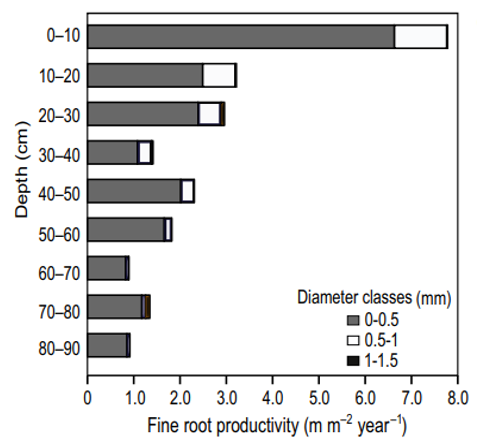The Science
A common assumption in tropical ecology is that root systems respond rapidly to climatic cues but that most of that response is limited to the uppermost layer of the soil, with relatively limited changes in deeper layers. However, this assumption has not been tested directly, preventing models from accurately predicting the response of tropical forests to environmental change.
The Impact
This study presents new direct estimates of fine‐root productivity and turnover in a Central Amazonian plateau tropical forest, as well as the factors controlling their dynamics, which are crucial to the understanding of above‐ versus below ground trade‐offs and linkages determining forest function. The findings demonstrate a relationship between fine‐root dynamics and precipitation regimes and emphasize the importance of deeper roots for accurate estimates of primary productivity and the interaction between roots and carbon, water, and nutrients.
Summary
Our objective was to quantify the patterns and controls of fine-root productivity, standing stock, and mortality and fine-root population turnover across the vertical soil profile in an Amazonian plateau tropical forest. We measured seasonal dynamics of fine roots with high spatial and temporal resolution using minirhizotrons to see below the surface in a mature forest in Central Amazonia. Minirhizotron measurements were calibrated with fine roots extracted from soil cores. Our direct observations of fine‐root dynamics to a depth of 90 cm enabled us to reach three important advances in our understanding of fine‐root dynamics in this site: (a) Although the largest fraction of fine‐root biomass and productivity is in the top 10 cm of the soil profile, a substantial fraction is deeper than 30 cm (46.1% and 40.6%, respectively); (b) As is often assumed but rarely observed, fine‐root turnover declined with depth; (c) Seasonal variation in precipitation drives root dynamics, but the direction and strength of the influence of precipitation varies with depth. Fine‐root productivity and mortality in surface layers were positively related to precipitation. Fine‐root stock was greater in dry periods in the deepest layer where water is likely more available at that time. Our data extend the quantification of root dynamics to deeper in the soil profile than previous studies in tropical forests, contributing to our understanding of ecosystem net primary production, carbon cycling, and environmental controls on fine‐root dynamics.

Contacts (BER PM): Daniel Stover, SC-23.1, Daniel.Stover@science.doe.gov (301-903-0289)
PI Contact: Richard J. Norby, Department of Ecology & Evolutionary Biology, University of Tennessee-Knoxville, rnorby@utk.edu, 865-603-0752
Funding
This work was supported in part by the U.S. Department of Energy, Office of Science, Office of Biological and Environmental Research Program, Climate and Environmental Sciences Division through the NGEE-Tropics program at Oak Ridge National Laboratory (ORNL). ORNL is managed by University of Tennessee (UT)-Battelle, LLC, for the U.S. Department of Energy under contract DE-AC05-00OR22725.
Publications
1. Cordeiro AL, Norby RJ, Andersen KM, Valverde-Barrantes O, Fuchslueger L, Oblitas E, Hartley IP, Iversen CM, Gonçalves NB, Takeshi B, Lapola DM, Quesada CA. 2020. Fine-root dynamics vary with soil depth and precipitation in a low nutrient tropical forest in the Central Amazonia. Plant-Environment Interactions, DOI:10.1002/pei3.10010.
2. Cordeiro AL, Valverde‐Barrantes O, Oblitas E, Gonçalves NB, Andersen KM, Quesada CA, Norby RJ. 2019. Fine‐root production, mortality, and standing stock from minirhizotron measurements, AmazonFACE site, Brazil. 1.0. NGEE Tropics Data Collection (dataset). http://dx.doi.org/10.15486/ngt/1523508.